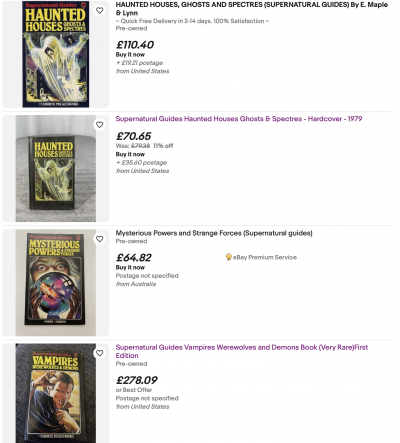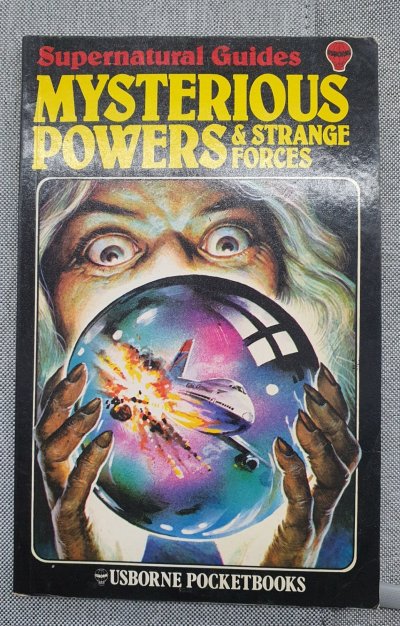Reference Image:
And we're into the book proper with another double-page illustration (a great many pages later on are subdivided).
Elements I like:
- The gloaming. Although the foliage to the lower left indicates that we are not, in fact, in Atkinson Grimshaw's protracted autumn, these golden sere skies that tend to descend into obscure iodine and russet shades invariably remind me of him; more functionally, they provide an attractive contrast for the black text and evoke intimations of mortality (to stand Wordsworth on his head).

- The house. I think we must be looking at a late-Tudor hall or manor house here (perhaps a Victorian copy). It's a slightly less glamorous specimen, but it's all windows: leaded and mullioned (two in crenallated bays) with a lovely slender chinney, an arched doorway with steps, and a curlicued rooftop finial—a very plausible site for a haunting! The abraded brickwork tells us that the building is old and locates the scene firmly in the present (despite the positively Biblical apparition), while the fiery glow from the lighted window reveals (in consonance with the text) that somebody is in residence; somebody, we assume, not currently aware of the horror outside his home—the reader alone is witness to that.
Elements I do not like:
- The ghost, unfortunately. I waver between thinking it's either a poorly realised concept or simply badly drawn. With his bald pate, flat pallor, emotionless features, and excessively flat chest, he could easily be mistaken for a golem or animate statue, but what, then, is one to make of the fastidiously trimmed beard and trendy winding sheet? He seems to be wearing the latter like a sarong, which makes me question whether it is, in fact, a winding sheet at all. His arms seem excessively long, and despite his otherworldly glow he doesn't quite look transparent enough on top to me. Is this the point though? Is he supposed to be in the process of materialising from the top downwards? All these questions proclaim 'failed concept' more than 'intriguing mystery' to me.
The Text:
Nothing revolutionary here, but a solid introduction, albeit one necessarily littered with modals of possibility and limiting quantifiers:
May x 5; Sometimes x 5; Many x 3; Usually, Very Often & Most x 1 each!
I'm rather taken with the opening claim that haunted houses can be seen as homes to mortals and spirits alike; they aren't simply the sites or these hauntings, the presences belong there as much as the living residents. This probably was not the author's intention, but it puts me in mind of all those tales wherein a family is aware of an additional presence and, after an initial shock or two, has come to an accommodation with him, her or it—a
modus vivendi in which they acknowledge the identity of the ghost and even make concessions to it in their words and deeds: '
Oh, don't say that—you know the grey man won't like it' or '
I'm sure Old Lucy won't take too kindly to those workmen in the lane!'
Indeed, the first two paragraphs strive to humanise the ghost. For all their strangeness, they are presented as much more similar than dissimilar to you and me. The possibility of less human-seeming lights and shapes is admitted, but the emphasis here is on those who are spirits of the dead: those who used to be
just like us. They walk and talk and moan and groan as you might in their shoes, and while they may be capable of impossible feats like passing through walls and manipulating objects, they deal primarily in the realm of our five senses with their draughts, smells and voices.
I suppose the emphasis of this introduction is that while the haunting phenomenon is surely strange, it is also inherently intelligible: there may turn out to be perfectly rational explanations, but failing that, there are experts on the subject (priests are cited) who have practical advice, and a diligent investigator might well be able to uncover the rationale behind a ghost's appearance. I think this rather sanguine approach would have been reinforced nicely had the text included examples of
when ghosts typically appear. Anniversaries are commonly cited, but phases of the Moon and periodically recurring events such as births, deaths, marriages and coronations have all been adduced as possible triggers. Then there's the final statement: that the causes for the apparently inexplicable still stand to be discovered in the future (tacit: by you?). This chimes perfectly with the last sections of the book that offer advice for investigating ghosts, identifying fraud, and theorising about hauntings.
If nothing else, our appetites are now truly whet for the colourful examples that will fit the templates sketched here.



